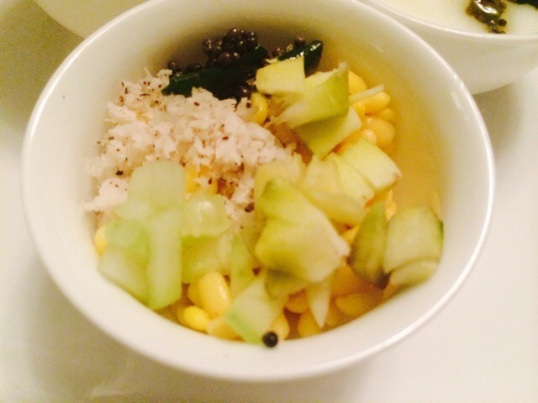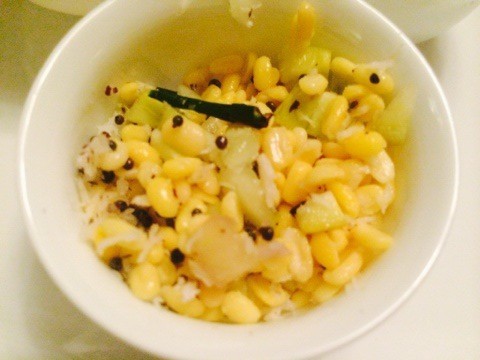A friend of ours recently introduced us to quinoa and all its benefits. Quinoa or KEEN-WAH as it is pronounced, is 100% whole grain and I was excited to note that not only does it have fewer carbs than rice but is a great source of protein – 12% to 18%. To learn more about Quinoa and its benefits, go here.
We had been trying to find alternative methods to cut down rice from our diet. Brown rice, broken wheat are all great alternatives, but I find that neither has the protein content that quinoa provides. Basically, quinoa seems the closest to providing a balanced nutrition, the carbs, protein, Vit.B etc.
Of course, we tried it as an alternative to plain rice and then mixed it with plain yoghurt for the traditional South Indian staple, thayir saadhan or rather thayir quinoa! The other characteristic of quinoa that differentiates it from brown rice or broken wheat is that though there is a slight nutty flavor, you cannot taste it at all when you mix it with spices or curries. This, to me, is a perfect alternative to white rice!
Girish came up with the brilliant idea of trying bisi bele huli quinoa today for lunch and my mother got equally excited with the idea and pulled out her staple recipe for bisi bele huli bhaath. She and I got busy making it and I have to say it was awesome. So if you truly want to try this with rice, the recipe is just the same, only replace the quinoa with cooked rice.
Ingredients:
Boiled Toor Dal (yellow pigeon peas) – 1 cup
Cooked quinoa – 1 cup (1 cup quinoa and 2 cups water in a pressure cooker, or a rice cooker)
Madras Sambar Powder – 2 1/2 tsp (you can use the MTR brand)
Turmeric – 1 tsp
Tamarind – lemon size soaked in water and made into a paste
Beans – 1/2 cup julienne sliced
Carrots – 2 julienne sliced
Peas – 1/2 cup
Cauliflower – florets 1/2 cup
Masala – to be ground into a paste
Onions – 2
Garlic – 8 pods (optional, if you dont like the smell of garlic, you can skip)
Red chilies – 8-10
Ginger – 2 inches
Khus Khus – 2 tbsp (poppy seeds)
Cloves – 4
Cardamom – 2
Dalchini (Cinnamon sticks) – 2
Grated coconut – 1/2 cup
Oil – 1/2 cup
Garnishing: cilantro – 1/2 cup, cashew pieces – 1/2 cup, mustard seeds – 1 tsp, curry leaves – a bunch, red chilies – 2
 Method:
Method:
1. Take 2 tsp of oil in a heavy bottomed pan, add all the ingredients for the masala and fry lightly for about 5 minutes.
2. Add the turmeric powder and fry again for 2 more minutes. Allow to cool.

3. Put all the ingredients in the pan, add the tamarind and the tomatoes and grind to a smooth paste. Keep this aside.

4. Now take the same kadai, add the remaining oil and lightly fry the vegetables for about 5 minutes.
5. Add the ground paste and continue to fry until the oil separates, for about 10 minutes. Then add the sambar powder.

6. Now add the boiled and mashed toor dal, add about a cup of water and leave it to boil, for about 5-7 minutes. Add salt to taste.
7. Now add the cooked quinoa to the above mixture, and mix well. Cook a little more for about 5 minutes until the ingredients are thoroughly mixed.
8. In a separate pan, add a little oil, about 1 tsp. When the oil gets hot, add the mustard seeds and fry till they crackle. Now add the curry leaves and the red chilies. Add cashews and fry till they brown a little.
Add this to the bisi bele huli quinoa. Garnish with chopped cilantro and serve hot.

Submitting this post to Cooking with Seeds event devised by Priya’s Versatile Recipes.

0.000000
0.000000
Posted by rozkakhana in
Amma's recipes,
Comfort Food,
Lentils,
Traditional South Indian dishes and tagged
bisi bele bhath made with quinoa,
bisi bele huli anna recipe,
bisi bele huli quinoa,
cooking with quinoa,
quinoa,
quinoa bisi bele bhath,
quinoa recipes,
rice substitute recipes,
sambar rice recipe











































